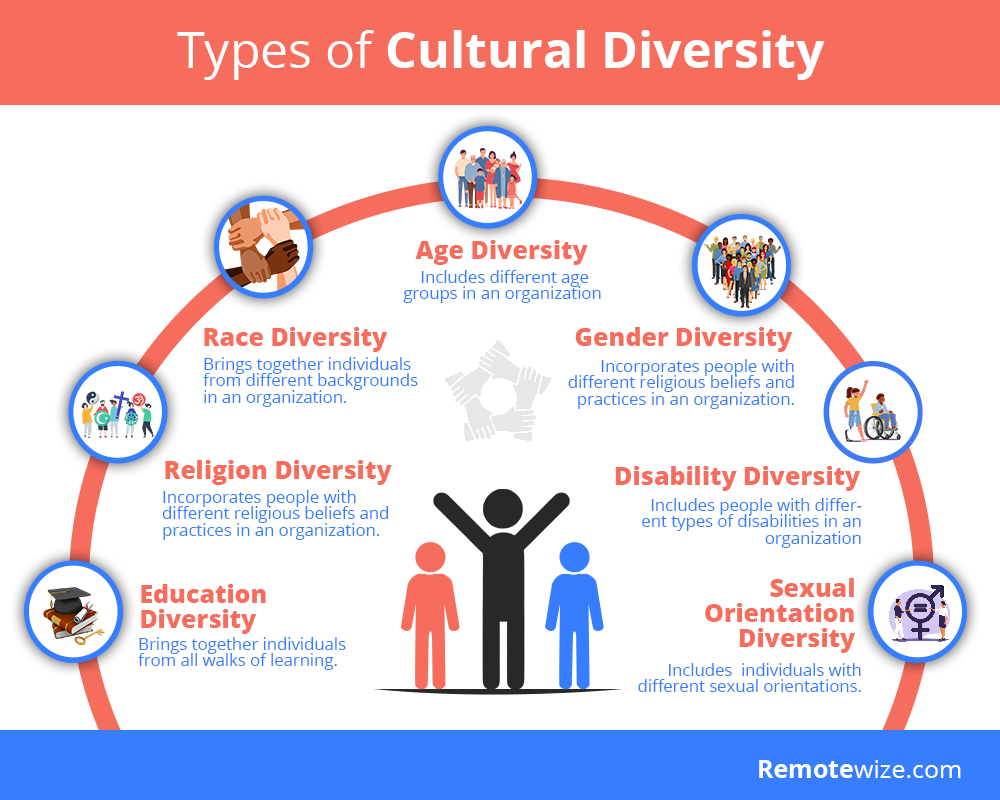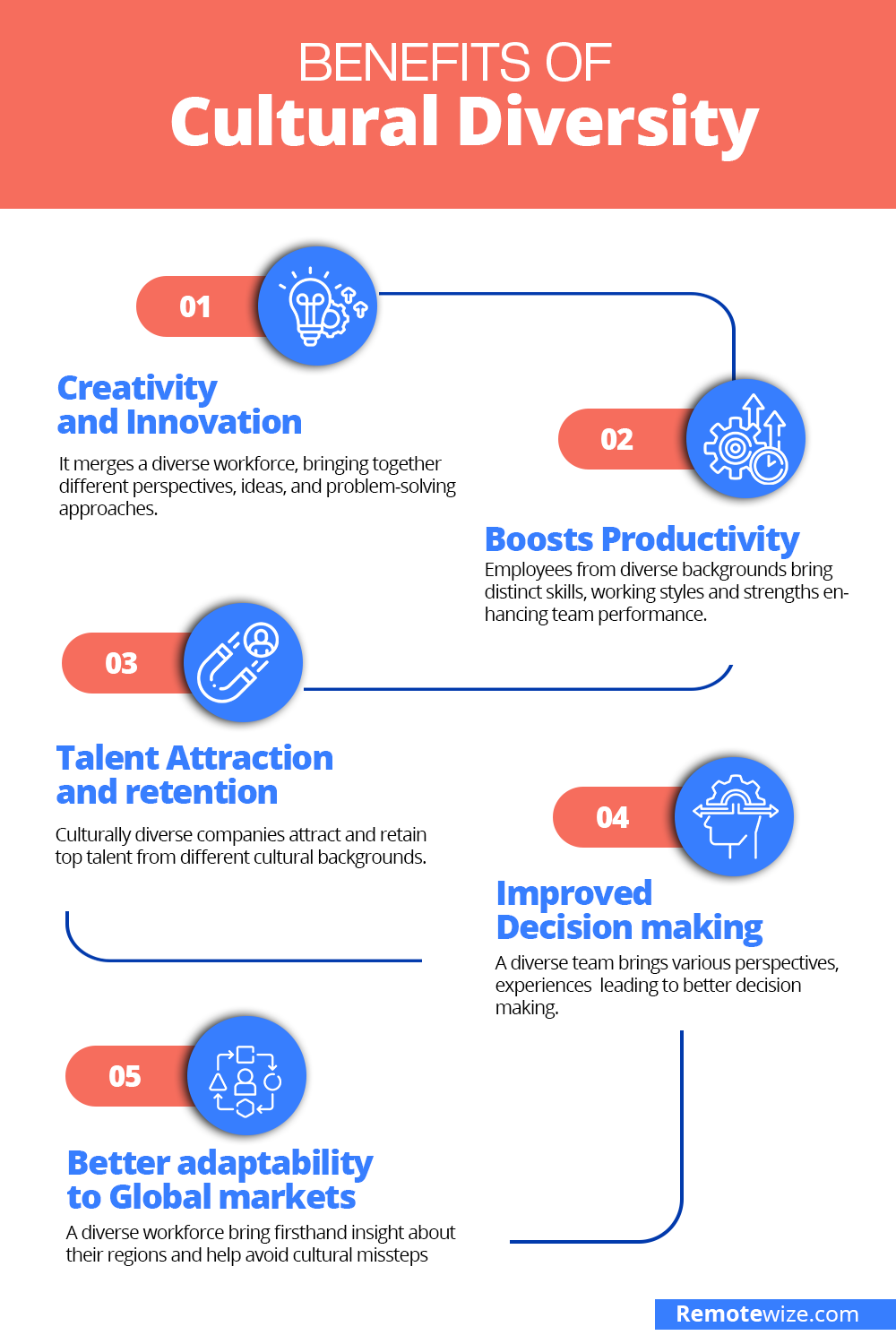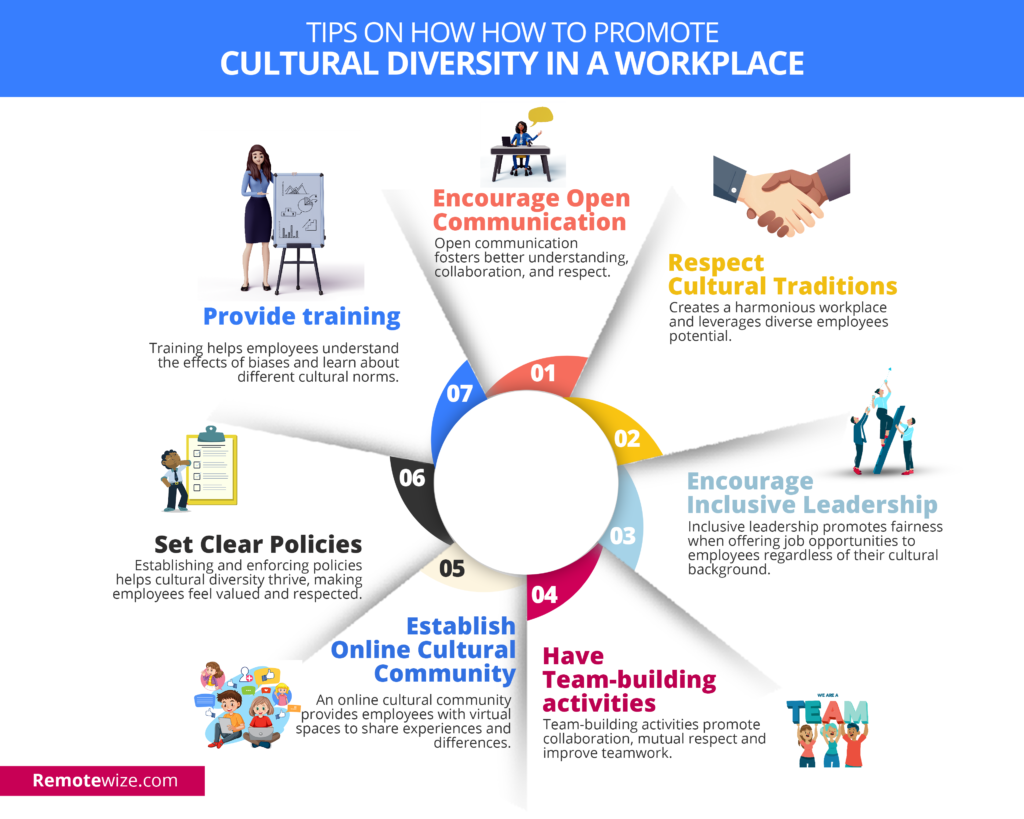The rapid rise of remote work has redefined how team-mates connect, collaborate, and thrive. With distributed teams, the modern workplace boasts a tapestry of individuals from various cultural, ethnic, and social backgrounds. The new reality has pushed businesses to find better ways to improve cultural diversity in the workplace.
But, doing so is easier said than done. While cultural diversity sparks creativity and drives innovation, it can be difficult to achieve in the modern workplace.
In this guide, we’ll explore cultural diversity for remote and distributed teams: its meaning, importance, and how to make it work. Keep reading to learn how to build an inclusive culture that turns a team’s differences into strengths.
Key Takeaways: Cultural Diversity in a Workplace
- What is cultural diversity: Cultural diversity is the blend of different backgrounds, traditions, and perspectives that people bring to the workplace, enriching collaboration and creativity. It encompasses diversity in race, ethnicity, language, religion, and even communication styles.
- Challenges of cultural diversity: Cultural diversity poses challenges like communication barriers, negative stereotypes, and conflicting work styles, which can hinder collaboration and team cohesion. Addressing these requires fostering understanding, mutual respect, and inclusive practices.
- Benefits of cultural diversity: Cultural diversity boosts creativity, innovation, and decision-making, while enhancing adaptability to global markets. Fostering an inclusive environment where individuals feel respected can significantly reduce employee turnover.
What is Cultural Diversity in a Workplace?
Cultural diversity in a workplace means having employees from different cultural backgrounds working together. It encompasses differences in language, ethnicity, traditions, religion, and customs that shape employees’ identities and ways of life. Bridging these differences can foster creativity and innovation in the workplace.
Types of cultural diversity in a workplace
Cultural diversity in a workplace manifests in different forms. Here are some major types;

- Age diversity: This refers to the inclusion of individuals from different age groups in an organization. It means incorporating employees with different perspectives and levels of experience.
- Race diversity: Racial diversity means having employees from different races, like Americans, Latinos, Asians, Europeans, and Indigenous people in your workforce.
- Religious diversity: This refers to incorporating employees with different religious beliefs and practices into an organization. This may include Christians, Muslims, Hindus, Jews, Buddhists, and those with no religious affiliation.
- Educational diversity: This means bringing together employees with different levels of education: high school, diploma, vocational, degree, master’s graduates, and more.
- Disability diversity: This means the inclusion of employees with disabilities, such as physical, visual, or autism-related, in an organization.
Benefits of Cultural diversity in a workplace
When you embrace and celebrate cultural diversity, you unlock a treasure trove of benefits for both your organization and employees. Let’s dive into some of the remarkable advantages of cultural diversity:
1. Creativity and innovation
One study found that an inclusive workplace is 1.7 times more innovative. When a team is inclusive, it merges people from all walks of life, bringing unique perspectives, ideas, and problem-solving approaches. This helps unlock a team’s creativity and innovation, enabling businesses to improve processes, adapt to market changes, and develop unique products or services.
For example, the team behind Google Translate brought together linguists and engineers from diverse cultural backgrounds. This diversity helped the team understand nuanced linguistic differences and create a tool that accommodates cultural contexts, idioms, and phrases. The result is a globally successful product that bridges language barriers.
2. Boosts Productivity
A study found that a 1% increase in racial diversity in an organization can increase productivity by up to $1,590 per employee per year. This is because employees from diverse backgrounds bring distinct skills, work styles, and strengths that complement one another. This synergy leads to streamlined processes, high-quality outcomes, and exceptional performance.
Also, an inclusive workplace boosts employee morale. When employees feel valued for who they are, regardless of cultural differences, they’re more engaged and motivated. The increase in engagement directly impacts organizational productivity, turning diversity into a driver of success.
3. Talent Attraction and retention
Companies that actively promote cultural diversity are more likely to attract and retain top talent. A survey by Glassdoor found that 76% of job seekers prioritize a diverse workforce when evaluating job offers. This proves that embracing cultural diversity can enhance your organization’s appeal to top talent.
Additionally, cultural diversity creates an inclusive and respectful workplace where employees feel valued for who they are. As a result, employees are more likely to be motivated, engaged, and committed. This can significantly strengthen loyalty, reducing turnover.
4. Improved Decision making
A research by People Management found that culturally diverse teams are 87% better at making decisions. When a team is culturally diverse, the workplace becomes a playground for a variety of perspectives, experiences, and problem-solving approaches.
Team members challenge assumptions, consider different viewpoints, and explore numerous options. This fosters critical thinking and creativity, leading to better decisions.
Google actively promotes cultural diversity within its workforce, recognizing that a variety of perspectives lead to better decision-making. Its diverse teams have helped create products that work well for people from different cultures, such as Google Translate and YouTube localization.
5. Better Adaptability to Global Markets
Cultural diversity enhances adaptability to global markets by bringing together a workforce with varied cultural knowledge, experiences, and perspectives. Employees from diverse cultural backgrounds bring firsthand insights about their regions, including preferences, traditions, and consumer behavior.
This helps organizations better understand and respond to the unique needs of customers from different regions and bases. For example, Airbnb’s culturally diverse team helps tailor offerings to regional travel preferences. The company has devised unique ways to promote homestays in rural areas for markets where authenticity is highly valued.

5 Challenges of Cultural diversity in a workplace
While cultural diversity enriches distributed teams with unique ideas, perspectives, and strengths, it also presents several challenges. In this section, we’ll discuss some of the common challenges and how to address them:
1. Communication barriers
Cultural diversity may lead to cross-cultural communication barriers due to differences in language, communication styles, and cultural norms. Let’s dive into each of these:
- Language differences: When remote team members speak different languages or have different levels of proficiency in a common language, misunderstandings can arise. A distributed team can struggle to communicate complex ideas effectively if some members are non-native speakers of the primary language. Misinterpretations of instructions or feedback can delay the progress of projects.
- Variations in communication styles: Cultures differ in how they express ideas, emotions, and opinions. Some cultures prefer direct communication (saying exactly what they mean), while others use indirect communication — relying on context or implied meaning. A direct communicator might find it challenging to interpret subtle, indirect feedback from a colleague. This can lead to confusion or misalignment.
- Different norms around nonverbal communication: Body language, gestures, and tone of voice can vary widely across cultures. What is acceptable or polite in one culture might be considered rude or confusing in another. A thumbs-up gesture — which signifies approval in many cultures — can be offensive to others. Misreading such non-verbal cues can strain interactions.
- Misaligned Expectations About Hierarchy and Formality: Cultural norms around authority and workplace relationships also influence cross-cultural communication. For instance, in some cultures, questioning a manager’s decision may be seen as disrespectful. However, in other cultures, it may be encouraged as part of collaborative problem-solving.
How to overcome communication barriers
- Use simple and clear language — Avoid idioms, jargon, and complex expressions that may confuse non-native speakers.
- Encourage active speaking — Train your employees to practice active listening, ask questions for clarification, and paraphrase to fully understand.
- Leverage communication tools — Use translation tools in the cross-cultural communication channels available to overcome language differences. Prioritize apps with built-in translation features like SpikeNow and Lark.
- Encourage feedback and continuous improvement — Regularly seek employee’s feedback about communication challenges through anonymous surveys and address them proactively.
2. Negative culture stereotypes
Cultural diversity can unintentionally lead to negative stereotypes when people make baseless assumptions about others. This may be due to the following reasons;
- Lack of Awareness and Education: When some employees lack knowledge about other cultures, they may rely on assumptions to understand unfamiliar behaviors or customs. A team member from Germany, a time-oriented culture, might think of a Brazilian colleague as “unpunctual” for arriving late for the first meeting, without understanding Brazil’s flexible approach to time.
- Misinterpreting Cultural Differences: Differences in behavior, communication, or values can be misinterpreted from the perspective of one’s own culture. This may lead to incorrect assumptions. A person from a culture that values modesty might perceive someone from a culture that emphasizes self-promotion as arrogant, reinforcing a negative stereotype.
- Media Influence: Media often shows simple and unfair images of cultures, which can strengthen stereotypes. These images may affect how people see others from different backgrounds in real life. These generalizations often evolve into stereotypes. An employer might stereotype all workers from Asian cultures as naturally good at mathematics or technology, overlooking their diverse talents and interests.
- Confirmation Bias: Once a stereotype is formed, people tend to notice and remember behaviors that align with that stereotype, reinforcing it further. If an employee believes his colleagues from a particular culture are less collaborative, they might focus on instances of disagreement while ignoring instances of teamwork.
How to Overcome Negative Stereotypes
- Promote awareness through education — Conduct training through workshops to help employees recognize how stereotypes affect their behaviors and decisions.
- Lead by example — a leader should model inclusive behavior and actively challenge biases when they arise.
- Celebrate diversity — Host events celebrating different cultures or feature diverse employees’ cultural stories in the company’s newsletter.
- Challenge media stereotypes — Share positive representations of different cultures, such as inclusive images in the workplace media materials.
3. Conflicting working styles
Conflicting working styles can create misunderstanding, hinder collaboration, and reduce productivity in a culturally diverse workplace. The differences arise due to the following reasons.
- Clashes over time management: Attitude toward punctuality and deadlines may vary with employees’ different cultures. A Japanese employee may be strict with time, unlike an African or Brazilian colleague, which can lead to frustration or disagreements.
- Different approach to teamwork vs independence: Conflicts may arise when employees have contrasting working preferences, i.e. collaborating versus working independently. An employee accustomed to individual accountability may struggle to adapt to a teamwork approach. Conversely, a team-oriented employee may find independent tasks isolating and stressful.
- Communication preferences: Different age groups may prefer different modes of communication. A Gen Z may prefer instant messaging and emails, while a baby boomer may value face-to-face communication for clarity and team connection.
- Attitude toward Work-life Balance: Generation views on work-life balance may vary from different employees, which may cause tension when setting working hours.
How to overcome Conflicting Working styles
- Encourage flexibility — Foster an environment where employees respect each other’s working styles.
- Set clear expectations — Come up with workplace norms for communication, time management, and decision-making.
- Promote cross-generational learning — Encourage mentorship programs when older employees share knowledge while the younger ones introduce new technologies.
- Celebrate strengths — Show appreciation for each employee’s unique work, no matter how they work.
4. Resistance to Changes
Introducing cultural diversity in a workplace may trigger resistance to new working methods or cultures. The resistance may result from
- Fear of the unknown: Employees may feel uncertain about how the diversity changes will affect their roles or work dynamics. If an organization introduces diverse hiring, some existing employees might fear competition or feel undervalued.
- Lack of awareness and understanding: Some employees may not fully understand the reasons for changes or the benefits of cultural diversity. They may perceive it as unnecessary and disruptive.
- Existing biases and stereotypes: Preconceived notions about certain cultures may make some employees resist changes. For example, some employees might resist forming multicultural teams, believing language barriers will hinder productivity.
- Insufficient leadership support: If a leader does not communicate or show the essence of cultural diversity, employees may not see its value. For example, a company may launch a diversity mentorship program, but if managers fail to participate, it can lead to low engagement.
How to overcome resistance to change
- Offer clear communication — Explain the benefits of cultural diversity and how it aligns with the company’s set goals.
- Lead by example — Ensure leaders visibly support and participate in cultural diversity initiatives and efforts.
- Celebrate success — Highlight the positive outcomes of cultural diversity in your organization to build acceptance and enthusiasm.
5. Adaptation Cost
Investing in cultural diversity and inclusion initiatives incurs financial and logistical costs. Here is how:
- Cost of adjustments: Adapting to diversity often requires training and resources that may incur extra costs. For example, a company that is introducing multilingual signage to accommodate non-native speakers will incur additional costs.
- Cost of redesigning policies: Organizations may need to revise policies to make them more inclusive, which requires resources. Introducing flexible policies to accommodate diversity might require adjustment of payroll systems and administrative workflows.
- Cost of hiring: Implementing workforce diversity may require tapping into new talent pools or redesigning the hiring process, incurring extra costs.
- Technology upgrade: A company may need to adopt tools or software to support diverse languages, such as scheduling platforms for international teams.
How to Overcome Adaptation Cost
- Leverage external partnerships — Partner with other companies that offer diversity training to reduce internal costs.
- Start small — Implement low-cost diversity initiatives first, then scale up gradually in a phased-out approach.
- Utilize Technology — Invest in cost-effective tools like online training platforms or AI-driven translation software.
Tips on How to Promote Cultural diversity in a workplace
Promoting cultural diversity in the workplace boosts creativity, collaboration, and innovation. But achieving true inclusivity requires intentional steps. Read on to learn some of the tips to create a thriving environment for employees from all backgrounds.

1. Encourage Open Communication Around Diversity
Create an environment where employees feel comfortable sharing their ideas, perspectives, and concerns without fear of judgment. Doing so encourages employees to share their cultural and ethnic differences. Additionally, conduct regular check-ins and feedback sessions to build trust and ensure everyone feels heard.
For example, encourage new hires to participate in interactive sessions where they share key aspects of their personal cultural background. This will help you understand the employee’s traditions, holidays, or communication styles, right from day one. Incorporate the insights into your workplace culture training. It helps the rest of the workforce understand and embrace your new hire’s cultural norms.
Additionally, create a regular “Culture Calendar” where employees can suggest cultural events or celebrations that everyone can participate in. By doing this, the company not only learns about its employees’ diverse cultures but also sets the tone for an inclusive and collaborative workplace culture.
2. Respect Cultural Traditions
Another way to enhance cultural diversity is by respecting employees’ customs, practices, and beliefs. You can achieve this by celebrating diverse holidays and allowing time off on culturally significant occasions. Also, respecting dietary preferences, like offering food options that fit different restrictions during company culture events shows respect.
Acknowledging and accommodating cultural practices makes employees feel accepted and valued. As a result, employees are more inclined to engage and contribute their unique perspectives. This mutual respect enhances collaboration and cohesion, strengthening the organization’s overall diversity and inclusivity.
3. Encourage Inclusive Leadership
Create an environment where diverse perspectives aren’t only welcomed but sought after. Recognize and embrace diversity, promote equality, and ensure that every employee has a voice regardless of their background, identity, or experiences. By actively seeking input from all team members, you’ll build a culture of trust, belonging, and innovation.
Inclusive leadership facilitates open communication to create a safe space where all employees feel comfortable sharing their ideas and concerns. At Google, diversity is a top priority, and an inclusive culture has led to programs like “I AM REMARKABLE”. This encourages individuals from underrepresented cultures to showcase their achievements.
A study found that an organization that practices inclusive leadership sees a 29% boost in collaboration. It also records a 20% increase in the quality of decision-making and a 17% improvement in team performance. Inclusivity leads to a better understanding of different employee views. This helps teams collaborate effectively and make smarter decisions that boost the company’s bottom line.
4. Have team-building activities
Team-building activities foster collaboration, mutual respect, and understanding among employees from different cultural backgrounds. Additionally, employees develop a sense of unity that improves teamwork, increasing overall productivity.
Here’s how to incorporate cultural diversity through team-building activities.
- Have cultural potlucks — Employees bring different cultural dishes and share stories of their significance.
- Hold workshops — Involve employees in interactive sessions and engage in activities that highlight diversity, such as “cultural Trivia”
- Have cross-cultural challenges — Employees organize games like “Escape Room” or “Solve the Puzzle” using multicultural themes.
5. Establish an online Cultural Community
Encourage all employees to sign up for online communities such as:
- Online ERGs (Employee Resource Groups): These diverse groups offer employees a platform to connect and support each other. They are focused on various cultural identities such as gender, race, or common interests. The HP companies offer centralized online hubs where employees can find answers and connect with peers, enabling a sense of community.
- Virtual cultural events: Create virtual events such as cultural festivals, cooking classes, and storytelling sessions. Encourage employees to take part in celebrating diversity, sharing their heritage, and learning about others.
6. Establish Clear Policies
Set clear policies addressing equal opportunity, anti-discrimination, and cultural accommodations to create a safe and supportive environment for all employees. Policies should clearly outline guidelines to prevent bias and encourage behaviors that value diversity. This may include:
- Inclusive Hiring Practices: Implement unbiased recruitment processes to attract candidates from diverse backgrounds.
- Anti-Discrimination Policy: Clearly outline zero tolerance for discrimination based on race, ethnicity, religion, or cultural background.
- Language Support Policy: Offer resources like translation services or language training to support effective communication in diverse teams.
- Cultural Accommodation Policy: Allow flexibility for religious observances, cultural holidays, and dietary needs.
- Training and Development Policy: Provide regular diversity and inclusion training to raise awareness and build cultural competence.
7. Train Employees
Leverage workshops, seminars and online courses to raise awareness, build cultural competence, and foster inclusive behaviors. Some of the training opportunities include:
- Start with Awareness: Educate employees about the importance of cultural diversity and its benefits, such as increased creativity, innovation, and collaboration.
- Interactive Workshops: Use role-playing, case studies, and discussions to help employees experience and address real-life scenarios involving cultural diversity.
- Unconscious Bias Training: Help employees recognize and address biases that may impact their interactions and decisions.
- Provide Cross-Cultural Training: Teach employees about cultural differences, communication styles, and norms to help them understand and respect diverse perspectives.
- Inclusive Leadership Training: Train managers to lead diverse teams effectively by fostering inclusivity, open communication, and fair practices.
Conclusion: Promoting Cultural Diversity
Cultural diversity in a workplace is the pillar to an organization’s overall performance and success. It’s a powerful asset that fuels creativity, innovation, and productivity. It also fosters open communication, respect, inclusive leadership, and a work environment where every person’s culture counts.
By actively embracing cultural diversity, you build stronger teams with a variety of unique ideas, perspectives, and experiences. With diversity of thoughts, employees are better equipped to spark new approaches and inspire innovative solutions. This makes your organization more adaptable, inventive, and competitive in a rapidly changing world.
To achieve these benefits, foster open communication and provide diversity training to increase awareness and understanding. You should also establish policies that create an environment where everyone feels valued, respected, and empowered.
How do you promote cultural diversity in your organization? What benefits have you achieved because of inclusivity initiatives? We would like to hear about your cultural diversity story.
FAQs: Cultural Diversity in a Workplace
Why is cultural diversity in a workplace important?
Cultural diversity in a workplace is important because it fosters creativity, innovation, better decision-making, and problem-solving.
How can I start promoting cultural diversity in my organization?
Begin by creating a culture of open communication, offering cultural diversity training, and most importantly, setting clear anti-discrimination policies.
Can cultural diversity in a workplace impact organizations’ success?
Absolutely, a diverse workforce is more innovative, adaptable, and solves problems better.




